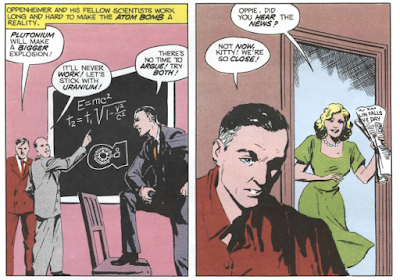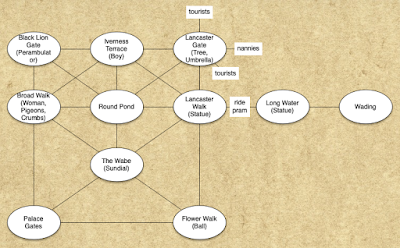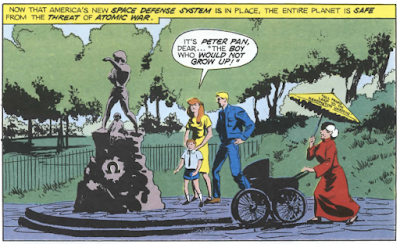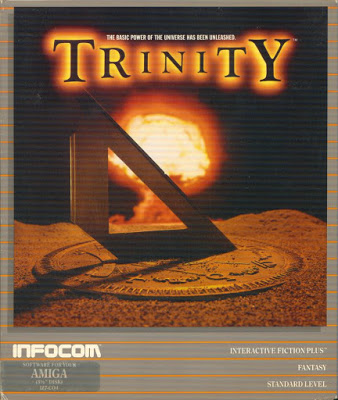From The Adventure Gamer
I should be at the beach and instead I am playing a game that is equal parts charming and deeply disturbing: Moriarty’s Trinity, a “fantasy” adventure game about inevitable nuclear armageddon. Much like A Mind Forever Voyaging, this is a game with a narrative purpose and a political bent, but also a product of its time. The Cold War had nearly boiled over and Moriarty’s message about the risks of nuclear proliferation was timely, even if I am uncertain how much anyone wanted to play a game about it. As I am writing this now, I’m not sure I want to play a game about it. At a time when nationalism is on the rise worldwide and new walls are being built, when Russia announces new “hyper sonic” missiles that are designed to pierce existing defense systems, and when North Korea promised a “Christmas present” that would let their own stockpile of nuclear weapons reach American shores, it’s hard to enjoy a game about it. We are still far from the brinkmanship of the Cold War when Russia and America played chicken with our lives, but it feels like the world is moving in the wrong direction.
I have been waiting to play this game for months. I had intended to rush it between Batman Returns and Consulting Detective II, but I pushed off after being warned that I would want to savor it. Beyond that, I don’t know all that much about the game itself. It was distributed on the second Lost Treasures set, so I owned it but never started it even once, nestled as it was in a submenu next to Sherlock Holmes and Wishbringer. I have since learned that it is considered one of Infocom’s finest works, but that is a reputation I was unaware of then and which I look forward to discovering the truth of now.
 |
| Boom, boom! Ain’t it great to be crazy? |
The title of the game comes from the Trinity site, the location of the first ever nuclear explosion in July 1945. Maybe you can blame my shoddy education, but I never learned much of this history in school. Of course, I knew about the Manhattan Project and the bombing of Hiroshima and Nagasaki (and I recall seeing the Enola Gay at the Smithsonian on one of my visits), but as for the history of the bomb, I was taught (or I remember) very little. That isn’t to say that the bomb wasn’t on our minds in the 1980s, but the threat of the bomb was a more immediate concern than the history of said bomb. I was in second grade in 1986 and not fully aware of what was going on in the wider world. When I was older, we were taught that Pittsburgh, where I grew up, would likely be a secondary target for the Soviets because of our capacity for (if not active development in) steel production. It was believed around the dinner table that our mountainous terrain would decrease the damage and keep us safe. I recall being told that people moved to the south of the city because it would be safer there in the event of a bombing. It’s likely that nothing I just wrote was actually true, only the musings of scared people telling half-truths to other scared people. Nuclear bombs were on our minds, but we were not educated about the bomb and what would really happen in the event of a strike. Thankfully, none ever came.
An included comic fills in much of my missing history, although I’m not qualified to say what may have been exaggerated or adjusted for effect. It documents in a campy and jingoistic way the history of atomic energy from an apparently near-future perspective, as an informative (1950s-style) comic. The style reminds me of the Fallout games and I would not be at all surprised to learn that they were influenced by Trinity in some way. The history starts in 1938 when Nazi Germany was the first to split the atom. I had to look this up to make sure that this wasn’t alternative history because I certainly never learned that Germany was first. Niels Bohr wants the United States to harness that energy for a bomb and enlists the aid of Albert Einstein to press the point to President Roosevelt. Pearl Harbor was attacked, the Manhattan Project began, and the scientists at Los Alamos got to work on their bomb. Throughout it all, the refrain “It’s my patriotic duty.” is repeated. Even after Germany left the war and the threat of a rival atomic program was over, the United States continues building the bomb. The impetus was gone but the patriotic duty remained. It’s chilling.
 |
| Now I am become Death, the destroyer of worlds. |
The history lesson continues through the eponymous test at Trinity followed by the bombings at Hiroshima and Nagasaki. The panels are structured to hint that intimizating the Soviet Union, not defeating Japan, was the true goal of the bombings. Naturally, the United States monopoly on the bomb ends quickly and now we’re scared again because the “reds” have one too. So what to do? Build a bigger bomb! This leads to the tests on Bikini Island and further escalations. The comic transitions to “today”, a near-future world where the United States still performs underground tests (in reality, they ended in 1992) and has completed a Star Wars-style orbital defense system (unworkable with 1980s tech in real life, but functioning well here.) The story ends with a scene of children playing in Kensington Gardens and a general promising that all of the missiles and bombs that were built and stockpiled would never need to be used.
In addition to the comic, the game comes with instructions for folding an origami paper crane and a cut-out of a sundial. I expect that the sundial will be used as a form of copy protection, mostly because the instructions for the paper crane seem difficult to render in a text adventure. The manual ends with a well-written explanation for what we are getting ourselves into. It’s in spoiler territory, but I’ll repeat it verbatim anyway:
You’re neither an adventurer nor a professional thrill-seeker. You’re simply an American tourist in London, enjoying a relaxing stroll through the famous Kensington Gardens. When World War III starts and the city is vaporized moments after the story begins, you have no hope of survival.
Unless you enter another time, another place another dimension.
Escaping the destruction of London is not the end of your problems, but rather the beginning of new, more bizarre riddles. You’ll find yourself in an exotic world teeming with giant fly traps, strange creatures, and other inconveniences. Time and space will behave with their own intricate and mischievous logic. You’ll visit fantastic places and acquire curious objects as you seek to discover the logic behind your newfound universe.
And if you can figure out the pattern of events you’ll wind up in the New Mexico desert, minutes before the culmination of the greatest scientific experiment of all time: the world’s first atomic explosion, code-named Trinity.
The development of this game took place over several years. It is well-known that Moriarty was thinking about the nuclear proliferation even during his Atari years and that these concerns informed the darkly pessimistic Crash Dive. The amount of research he poured into this game is tremendous: the manual lists forty texts in his bibliography. You will, I hope, forgive me for not reading them all before playing the game; I expect that most players wouldn’t have taken on the equivalent of a college-level course in nuclear history before playing! Moriarty actively developed the game at least since the summer of 1985 when he visited the Trinity site, Los Alamos, and several museums devoted to nuclear history. I’m told that he also visited Kensington Gardens, but I have not been able to verify that fact. (I have previously reached out to Mr. Moriarty for feedback, but I regret that he has not yet responded to my queries.) Infocom was taking a risk on Moriarty by allowing him to do another “political” game so soon after the previous one failed, but at least this one would have puzzles. (The New Zork Times article promoting the game goes out of its way to stress that yes, this is a game with puzzles.) How well will all of this come together? I know only one way to find out: Let’s play!
 |
| The adventure begins! |
Our adventure begins in Kensington Gardens, part of Hyde Park in London. It’s a beautiful place that I have been to a half-dozen times, although never in a near-future dystopian fantasy. Our character has decided to leave his tour bus and camera behind in favor of seeing the sights on his own. The manual already told us that we’re about to be nuked, so it’s oddly tense. I have a pit in my stomach. It’s difficult to want to play this game.
North of our starting location is the Broad Walk where I am greeted by a flock of pigeons. An old woman sits nearby selling bags of crumbs to tourists for just 20p. I check my pockets and have only a 50p coin (as well as a nearly-expired credit card); am I supposed to get change first? I buy the crumbs anyway and she gives me a 20p coin in exchange. Just as in Wishbringer, we get a “beep!” sound and a notification that our score increased by one point. I’m one percent through the game! I like this feature and I hope that we see it in more Infocom games in the future.
I feed the birds some crumbs and– gasp!– there was a large ruby hidden in the bag. It slips between my fingers and lands on the ground. When I reach down to grab it, a roadrunner appears out of nowhere and snaps it up before running off to the east, racing between the legs of park-goers. Before I can even consider whether roadrunners are native to Britain (they are not), the old woman shouts, “It’s time!” and I score a few more points. My descriptions are not doing justice to a well-written game and a well-written sequence. It’s one part whimsy and one part tense, with a smattering of Alice in Wonderland-style strangeness. Moriarty is great at his craft!
I chase after the bird and find myself at the Round Pond, a charming area where children sail boats on the fountain while the ducks look on in disgust. The roadrunner continues as soon as he sees me, dodging baby carriages (“perambulators” or “prams” in London-speak) and disappears east once again. I follow him again to arrive at the Lancaster Walk. He scoots east again across a grassy lawn and I try to follow, but the game politely tells me to read the sign first. The sign says not to walk on the grass, but surely that notice doesn’t apply to roadrunners or adventurers? I follow that bird, but the grass reaches out and stops me! It’s some near-future attack grass and it deposits me back on the path. There’s no obvious way to follow our roadrunner friend any further.
 |
| Meep-meep. Phtttbt. |
I’m Googling while I am playing, a luxury that the original players in 1986 would not have had. Moriarty is doing a fantastic job modeling the real Kensington Gardens. The statue of a horse and rider here on the Lancaster Walk, for example, is called “Physical Energy” and exactly matches the one in the real garden. As I stand there admiring the scenery, someone bicycles over the grass without a problem. Is that the trick? Do I need to find a bike?
North is the Lancaster Gate where an elderly Asian woman struggles to open an umbrella. I move to help her, but am taken aback by her face. It is, to use the game’s word, “wrong” and “badly scarred, as if in an accident”. It stops me in my tracks. I’m shocked at the crassness of our avatar, especially as the nature of the game and the lengths by which it goes to draw attention to her scarring suggests that she is a survivor of Hiroshima. I’m not sure if that works timeline-wise, unless we’re not as far in the future as I thought. A gust of wind takes the umbrella and lodges it into a nearby tree. The woman begins to cry before kicking the tree and walking off. Am I supposed to find a way to recover it for her and return it? I don’t see an obvious way at it either since I cannot climb the tree. I’ll come back later.
We cannot explore the full garden as we are blocked when we head in directions the game doesn’t want us to go, for example by indignant nannies to the east and a mob of tourists to the north. I explore south to the Flower Walk and discover a soccer ball discarded in the grass. Grabbing it increases my score by a point! Can I use it to dislodge the umbrella? The game goes out of its way to call out how ugly the nearby Albert Memorial is. It’s a statue of a guy on a horse and apparently was super ugly in the 1980s but has been restored now. I doubt I ever gave it more than a passing glance.
Tossing the ball at the umbrella dislodges it, but then I lose the soccer ball. I score five points, so it must be a good trade! It has a touristy slogan along the side, “All Prams Lead to Kensington Gardens”. (This is a slight paraphrase from an expression in J.M. Barre’s The Little White Bird, the first story to include a version of Peter Pan. All that research that I did for Hook is paying off!) I open the umbrella and am immediately blown eastward by the wind, knocking me into a group of nannies. There might be a Mary Poppins joke here someplace. I get the idea that you can perhaps use the umbrella to force your way across the man-eating grass, but the grass doesn’t seem to care that I am wind-powered and pulls me back anyway.
Heading west, we discover the Inverness Terrace. A boy sits nearby wearing headphones and blowing bubbles. When one pops, we are treated to a “popup” quote that appears in the top half of the screen:
 |
| “Atoms or systems into ruins hurled, / And now a bubble burst, and now a world.” |
It’s all very poetic, but when I try to talk to the boy or take his headphones, he runs off. Was he rude for ignoring me? Or was I rude for bothering a kid just enjoying a summer’s day blowing bubbles in the park? I should have let him enjoy the last few minutes of his life.
Since time is running out, I resolve to explore and map the rest of the gardens:
- To the west is the Black Iron Gate where a careless nanny has misplaced a pram. Fortunately, there is no infant inside.
- When I return to the pond with the sail boats, I discover that one of them is actually an origami crane, just as in the manual. I unfold it for a cryptic message: “Long Water, 4 PM.” It’s 3:44 PM now.
- Northeast of the Palace Gates is “The Wabe” with a strange sundial exactly like the one in our packaging. It is seven symbols on it and the sun’s shadow is currently pointing at the first symbol. Strangely, the first symbol is labeled with “Omega” and the last with “Alpha”. That seems backwards but perhaps suggests that we will be working our way further back in time? I don’t know enough of the Greek alphabet to recognise the rest of the letters.
Arriving at the sundial also gives us an Alice in Wonderland quote:
“And the ‘wabe’ is the grass-plot round a sundial, I suppose?” said Alice, surprised at her own ingenuity. “Of course it is. It’s called ‘wabe,’ you know, because it goes a long way before it, and a long way behind it. – Lewis Caroll
If I had to guess, I’d say that we had seven sections to this game, corresponding to the seven symbols. Will Kensington Gardens become something of a “hub” for me while I explore other times? I go to leave, but the game does some amazing hinting and I am alerted that the wind is causing the “gnomon” to scrape against the metal of the sundial. I discover that I can unscrew it and take it with me. What is a “gnomon”, you ask? It’s the triangular bit of the sundial that casts the shadow. Yes, I had to look that up in a dictionary to make sure it was a real word. “Wabe”, despite the Alice quote, means absolutely nothing; it is a fake word created for “Jabberwocky”.
I’m nearly out of time, but the whole of the park is only nine locations and I try everything I can think of. I work out that I can push the pram around, but that doesn’t allow me to impersonate a nanny adequately enough for one of them to let me pass. It’s not until 3:53 that I discover the trick: I can ride inside the pram! I have no idea how I fit, but apparently I squeeze in. By riding in the pram and unfurling the umbrella, I can “sail” across the killer grass to the Long Water! It’s easy except I crash, drop all my stuff, and break the pram. Oh well.
 |
| My map of Kensington Gardens. |
 |
| Which doesn’t seem that far off from the real deal! |
I check my watch and it is 3:59, but the second hand has stopped moving. I gather up my stuff when I notice that a missile hangs nearly motionless in the sky. I say “nearly” because it is actually falling very slowly towards the Long Water. In the center of the water is a strange white door. As I watch, some birds (unaffected by the time dilation) fly through the door to parts unknown. Obviously, my best choice is to “make like a tree and leaf” through the door. I wade through the water to get closer when the roadrunner from earlier runs by, still with the ruby in its beak, and disappears through the door. As the world is destroyed by nuclear Armageddon, I hear a voice telling me to “be quick”:
“This way, please.”
You turn, but see no one.
“This way,” the voice urges. “Be quick.”
The space around you articulates. “No!” your mind shudders, “That’s not a direction!”
“It’s a perfectly legitimate direction,” retorts the voice with cold amusement. “Now, come along.”
As we pass through the door via the “perfectly legitimate direction”, the prologue ends and we are finally given a proper title card:
 |
| A title screen! |
I emerge from a door in a toadstool into a strange meadow. Far to the east, a meteor strikes. I’m not in London anymore, but that will be enough for today.
A few more bits and pieces:
- I did not notice it while I was playing, but the Kensington Gardens comic panel in the manual depicts the old woman and her distinctive umbrella. Strangely, she is pushing around a pram but she did not have one in the game itself. Am I to surmise that she was the one that left it there for me to find? Or am I digging in too deep?
 |
| That kid isn’t going to grow up either. :/ |
- There is no indication as to when in the near-future this game takes place, at least not yet. Since Moriarty wasn’t psychic, he didn’t know that the Berlin wall would fall or that the Soviet Union would collapse (both in 1991). Our only clue is that the Star Wars defense system is up and running and the cost of a tour was $599. Not a lot to go on! If the old woman was scarred in the Hiroshima bombing (a stretch based on the clues so far, but I’m thinking that is what Moriarty is going for), that puts the upper bound somewhere between 2000-2020. We’ll see if the game offers further clues later or if we’re just supposed to interpret it as “Next Sunday, A.D.” to quote a somewhat less serious sci-fi classic.
Time played: 1 hr 20 min
Inventory: gnomon, piece of paper, bag of crumbs, small coin (20p), credit card, umbrella, wristwatch
Score: 15 of 100 (15%)
Now it is time to guess the score! Looking at Moriarty’s scores to date, we have Adventure in the Fifth Dimension with 13, Crash Dive! with 20, and Wishbringer with 46. Infocom’s current average overall is 40 points, excluding the short tutorial game. He’ll also eventually write Loom, a game that we already scored as 65 and is currently tied for the tenth best game of all time on our site. Although I haven’t played it yet, it would be unfair of me not to mention that this is sometimes considered the best game Infocom ever created. My opinions may not match the general consensus, but I enjoyed this introduction portion well enough (even if I find the subject matter macabre) and I am curious to see how the game progresses.
Note Regarding Spoilers and Companion Assist Points: There’s a set of rules regarding spoilers and companion assist points. Please read it here before making any comments that could be considered a spoiler in any way. The short of it is that no CAPs will be given for hints or spoilers given in advance of me requiring one. As this is an introduction post, it’s an opportunity for readers to bet 10 CAPs (only if they already have them) that I won’t be able to solve a puzzle without putting in an official Request for Assistance: remember to use ROT13 for betting. If you get it right, you will be rewarded with 50 CAPs in return. It’s also your chance to predict what the final rating will be for the game. Voters can predict whatever score they want, regardless of whether someone else has already chosen it. All correct (or nearest) votes will go into a draw.
Original URL: https://advgamer.blogspot.com/2020/01/missed-classic-82-trinity-1986.html

